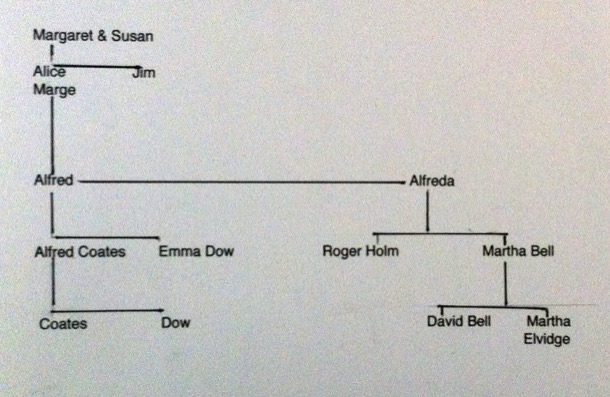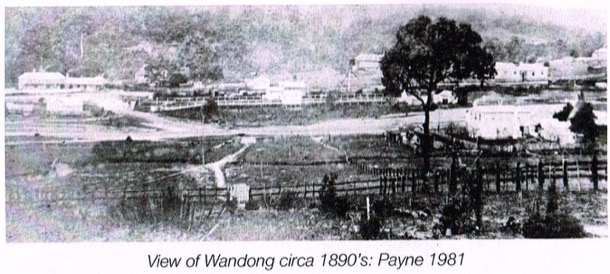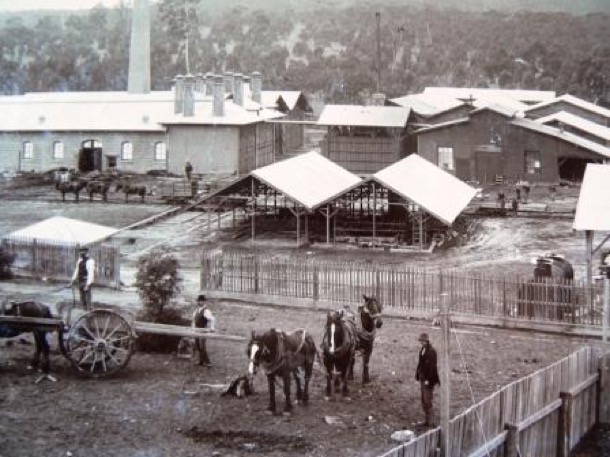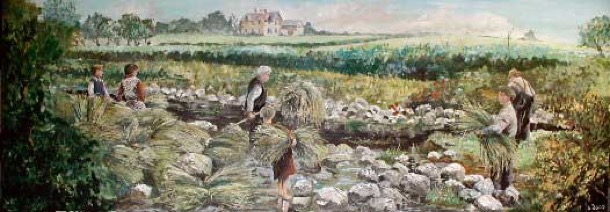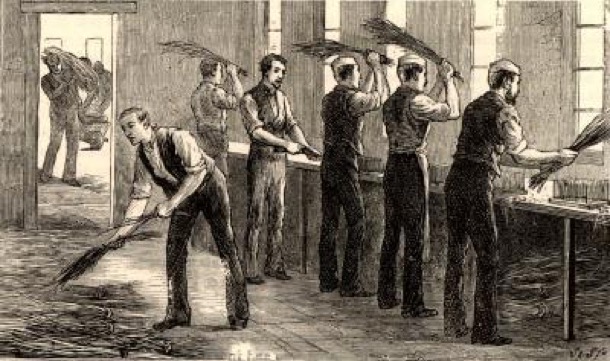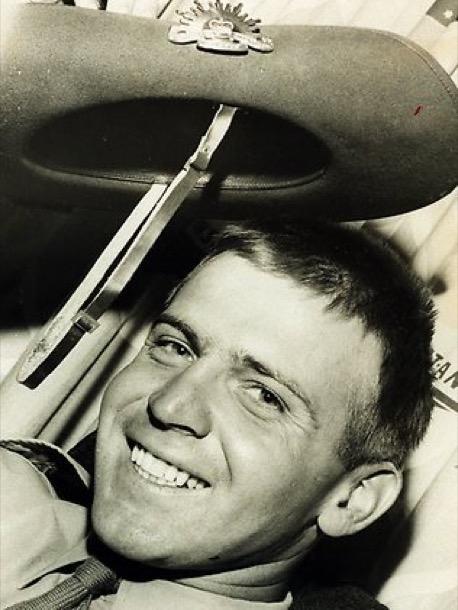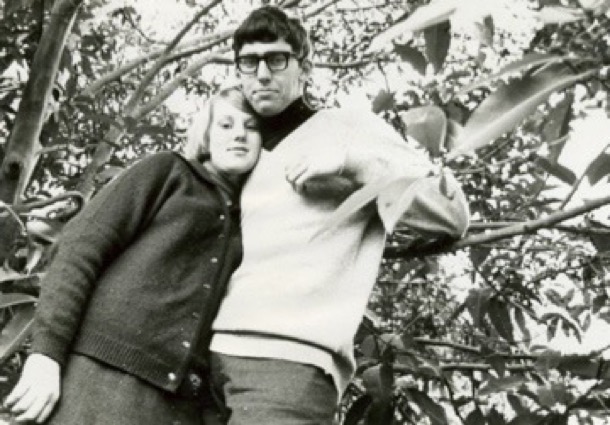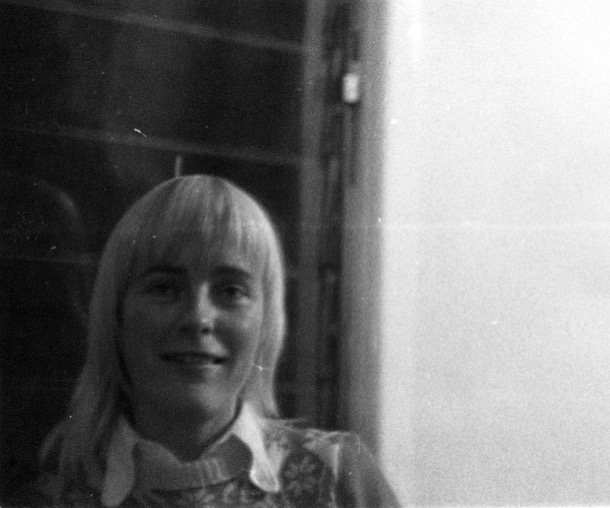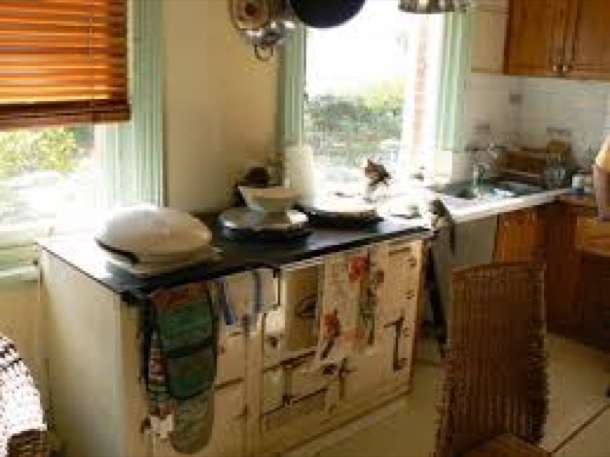Great Great Grandparents
Like many Australian families, ours is a story of migration to a new country. All four of our maternal great great grandparents were European: English, German, Danish and Irish.
These four migration stories happened between the 1850s and 1870s. Three of the migrants were our great great grandparents, and one was a great grandparent.
COATES, ARRIVED VICTORIA 1860s
Coates was an English engineer who travelled with his wife to Australia in the 1860s. Their first names are not known.
The Barwon River is the large river than flows through Geelong. In the new colony, there were no iron works: the worked iron had to be imported from England, along with the experts to do the work.
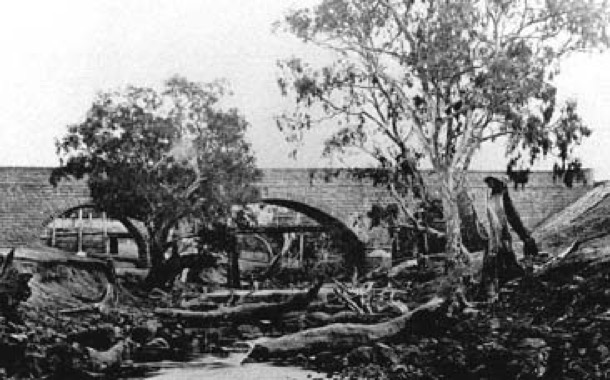
Barwon Bridge then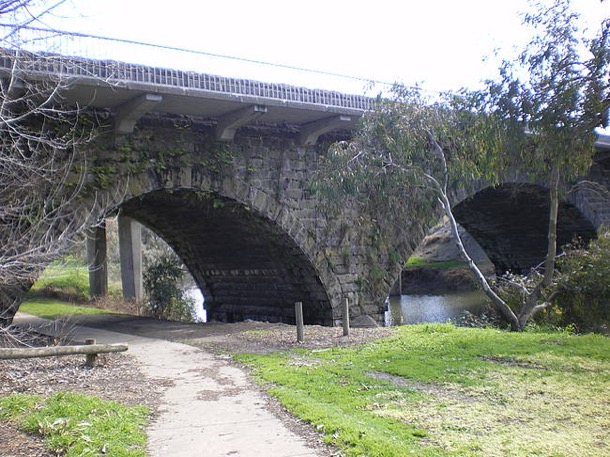
Barwon Bridge now
We don’t know whether Mr and Mrs Coates planned to do this job and then return to England, but they would have found a thriving, wealthy colony. Gold had been discovered in central Victoria just ten years earlier.
DAU, ARRIVED VICTORIA 1860s
Dau was a German farmer who arrived in Australia in the 1860s. He married a fifteen year old girl, of whom we know very little. Wandong is 70 Kilometres north of Melbourne. In the years the Daus lived there, there was a thriving timber industry and some gold mining. By 1880 there was a railway line from Melbourne.
HOLM, ARRIVED ADELAIDE 1872
Roger Holm: this one is our great grandparent, a baker, who himself arrived in Australia from Denmark via England in 1872.
Roger had been born in a part of Denmark called Schleswig-Holstein, that had been disputed territory for centuries. At the time when he was a child, Germany did not yet exist. It was still a whole lot of little countries. When Roger was twelve, Otto Von Bismarck’s army invaded Schleswig-Holstein.
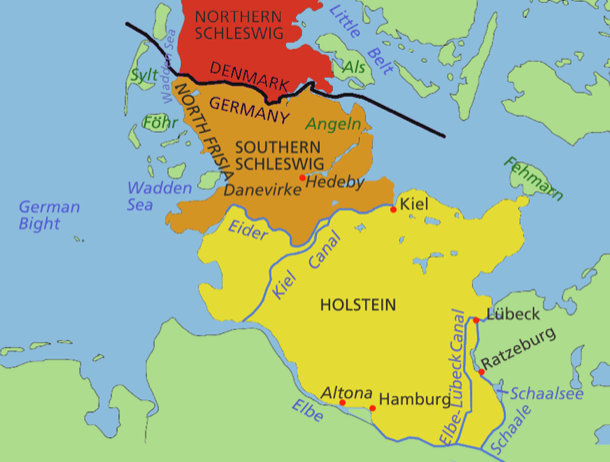
Map of Schleswig-Holstein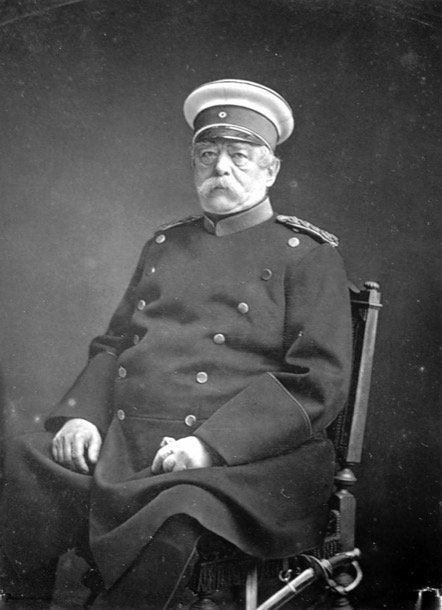
Otto Von Bismarck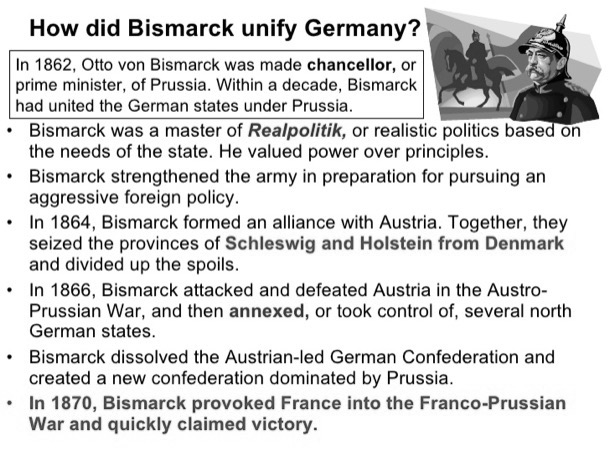
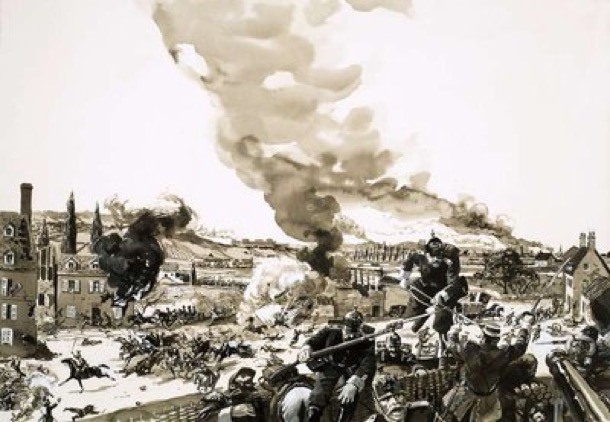
Painting: Bismarck Wresting Schleswig Holstein From The Danes
BELL, ARRIVED VICTORIA 1850s
David and Martha Bell was an Irish flax farmer, who arrived in Australia with his wife Martha (born Martha Elvidge) in the 1850s. Belfast was a prosperous modern city at that time.
The area had become a specialist for farming and processing flax, which was woven into linen, used among other things for ships’ sails.
Sue, Margaret, Rikki and Fred
Susan:
The 1960s was rather a bleak period in my life. The break up of our parents’ marriage, and the aftermath, had a profound affect on many lives. For me, in the sixties, it robbed me of my adolescence, at time when one should be free to learn, gain confidence and independence and, something always close to my heart, have adventures. This unusual friendship between my sister Margaret, her boyfriend at the time Fred and another girl, Rikki, provided just that, for which I will be forever grateful.
Margaret:
Fred had been called up. He was 19. The marble with his June 5th birthday had been drawn out of the barrel. National servicemen were dying in Vietnam. Glamorous pop star Norma Rowe, whose name had been on my pencil case for a while, was the Nasho poster boy, but the black and white TV screens showed the horror of guerrilla jungle warfare, in the kind of detail that would change the coverage of war for ever. After Vietnam, governments learnt to control the footage and the access. But in Vietnam we saw it all.
The Seekers' “If you go away On this summer day Then you might as well Take the sun away….” had been all over the radio that summer. Sixteen and prone to drama, I wallowed in the emotion of my lovely boyfriend being sent to Vietnam.
Fred was sent an appointment for a medical. Luckily he failed the medical and was reprieved. Another family friend who was an offical conscientious objector had to face court, and many went to jail.
Susan:
A breath of fresh air from the outside world came rushing into my life bringing with it new books to read about sea otters in Far North Scotland and Moomins; movies; photography; Carlton; fairy toadstool rings under pine trees at the Basin and above all the magical world of the Australian High Country. Rikki had an interest in the romance of the High Country, as she loved Elyne Mitchell’s books, one of which is the classic The Silver Brumby, a favourite of children of our era. Other books written by Elyne Mitchell are also based in the High Country and tell of her early married life to Tom Mitchell who had grown up in the area.
They lived on his beautiful family property with a view of the Main Range. Here they pioneered the skiing in this area, getting to the tops by horse and pack horse and then walking up a steep ridge from Geehi carrying their skis. We too were captivated by this world.
Rikki corresponded regularly with Elyne Mitchell, who, as you can imagine, was a fascinating woman. Fred also had a connection to this area, as he had spent his childhood and adolescence near Corryong. I had been through the Snowy Mountains on a school trip and was intrigued by this new world. We were all hooked, and thus began the adventures in the mountains.
I will never forget the excitement and thrill of discovery of that first trip in Easter, 1968. We set off up the Hume on Thursday night in the car our father very kindly lent us. A little after midnight, as we drove between Tallangatta and Corryong, we were telling the current scary story of a man on the roof of the car with a severed head. It was especially scary when we stopped to have a sleep in a bus shelter by the side of the road, too tired to go on. At least we had the sense to stop, even if it was freezing, especially sleeping on a concrete floor.
We were so naive and badly equipped for our trip. We camped at Khancoban , all sleeping in the same tent, bizarre, but we only had one, and then drove up to Seaman’s Hut on the Kosciusko Road and walked across to Albina Hut.
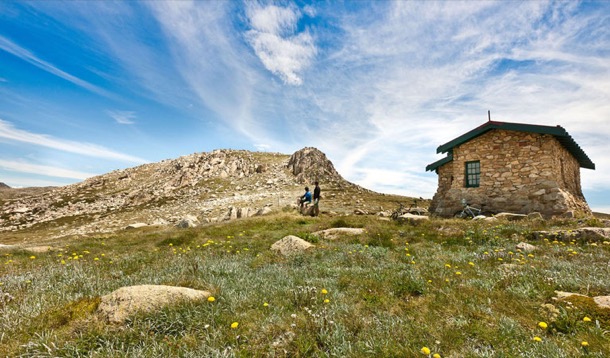
Seaman's hut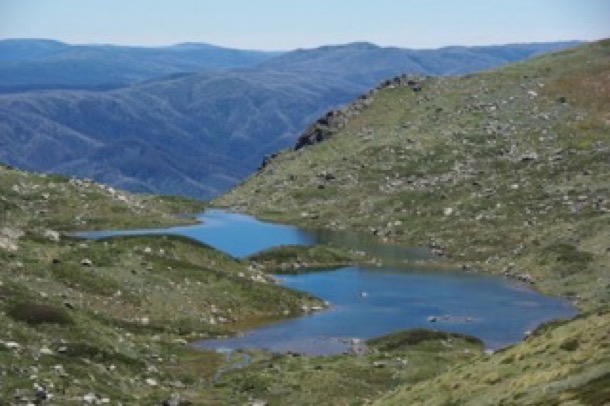
Lake Albina, viewed from Albina hut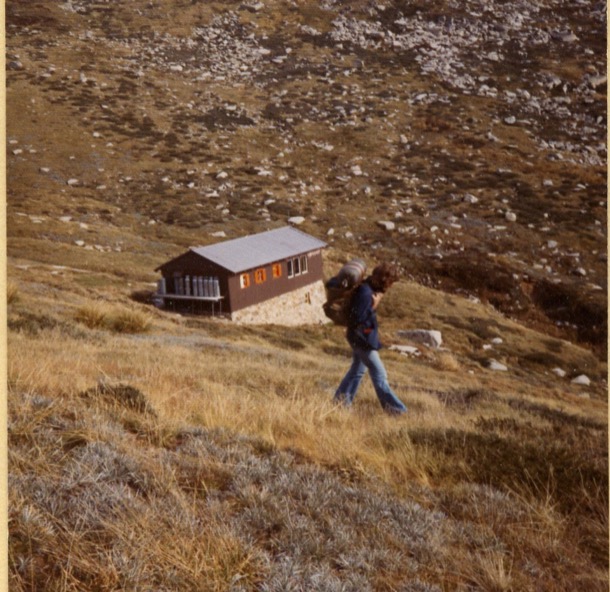
Fred, in front of Albina hut, this time with a pack.
Albina Hut is in a beautiful glacial valley just below Mt Townsend, which is only nineteen metres lower than Kosciusko. Dangerous country to walk in with no tent, no proper mountain clothes and no previous experience. Fred even carried a suitcase and an umbrella!!!! What a sight we must have been to the seasoned mountain walkers who were also staying in this hut that belonged to the Geehi Ski Club. I don’t remember anyone commenting or even warning us about the rapid weather changes.
It was fabulous. Loved every minute of the walk: the snow grass, the flowers the stunning granite tors and luckily the cobalt blue sky. My love affair with grasses began here, as did my joy of walking in the mountains.
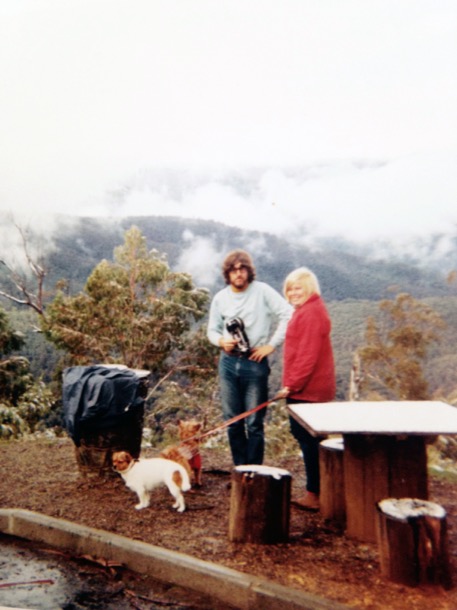
Sue and Fred in the Snowy Mountains
Margaret:
Around that time Rikki, Sue and I moved in together to the flat at the back of our parents’ house. We ate with the rest of the family, but it was a taste of independence. Sue was studying Art teaching in the city, Rikki was working full time, Fred was in his final year of Photography at RMIT and I was in my final year of school. Somehow through that year, in between weekends away and nights at the movies or out to dinner, I managed to snatch enough study time, but only just. I squirrelled myself away in Mum’s bedroom for the last couple of weeks before the exams.
That summer, after Christmas, we travelled up the Hume again, this time in Rikki’s little Volkswagen, “Greymouse”. Fred had spent his childhood living in Walwa, just over the NSW border, where his parents both worked at the Butter Factory. Family friends owned a farm that backed onto the Murray River near Corryong. Fred had spent childhood holidays exploring the river and knew of an island, reachable by car for most of the way, through the farm tracks. We lugged all our camping gear through the bush, waded over the river and set up on the island. I remember heat and flies, but also ants. We had a bush table on which the camp stove sat. Cooking required a tarp, on the ground in front of the table, wetted with river water, to keep the tiny ants from swarming up one’s legs.
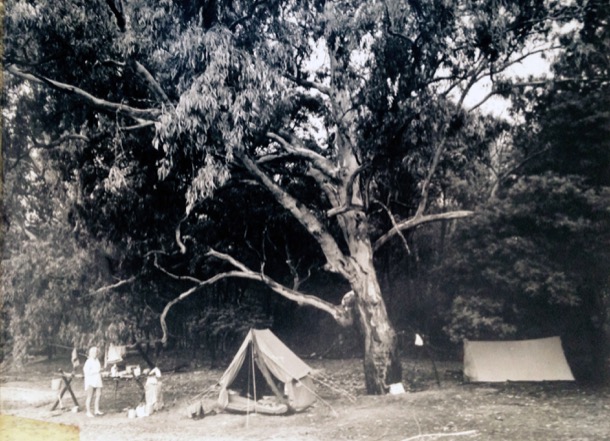
Camp on the island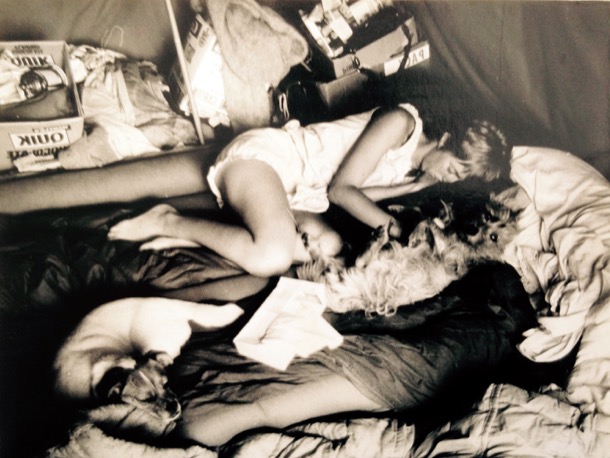
Inside the tent
Most of the time we were blissfully alone. However I remember lying naked in the river, hearing voices in the distance and being invaded by a scout troop on a canoeing expedition. I remember my acute embarrassment, lying in the all too shallow river. There was pointing and laughter from the scouts and unsympathetic mirth from my companions.
One night we drove to Corryong to have dinner. Afterwards, in the dark, perhaps a little drunk, we found our way back along the farm tracks, hiked through the bush and waded across the river back to our camp. We had torches, but in those pre LED days, torches were dim affairs which barely gave any light.
My exam results came out during that week and a simultaneous announcement of tertiary placements. This involved buying the Age newspaper and looking up your name. Once again we made the trek out to the car and drove to town. I was full of trepidation. How could such a distracted year and so little work end up with a place at Monash? Somehow it did. I was offered place in Monash Arts and a studentship.
Sue:
Our last trip together to the mountains was a year later, in January 1970. A very different experience but we followed our established pattern of the now many trips up here. We were on our way from Corryong to Khancoban all packed together in Rikki’s grey Beetle. In this small car we managed to pack four adults, two dogs, camping supplies and food. Unbelievable! It was very hot and the grass was straw coloured against a blue, blue sky when around the bend on the wrong side of the road came a car, driven by a worker from Snowy Hydro: a head-on in a rear-engined Volkswagen. We were very lucky.
Unhurt except for bumps on the head and a substantial coating of flour from an open packet in the food box we stumbled out of the car which was undrivable but only slightly damaged.
We did not get to the mountains, but we did get to stay with Elyne Mitchell at Towong Hill for two days, dogs and all. Mrs Mitchell happened to be driving past, saw the accident scene and took us in. With all our goods and chattels now in Mrs Mitchell’s Landcruiser, we drove back towards Corryong, but this time took the turn off to ‘Towong Hill’. We had so often passed the turn off, wondering about the house, hidden by large trees at the end of the small dirt road.
It was a marvellous experience, staying in that big old house, a large two story brick house, built in 1904, even though Mrs Mitchell was a slightly forbidding and austere presence.
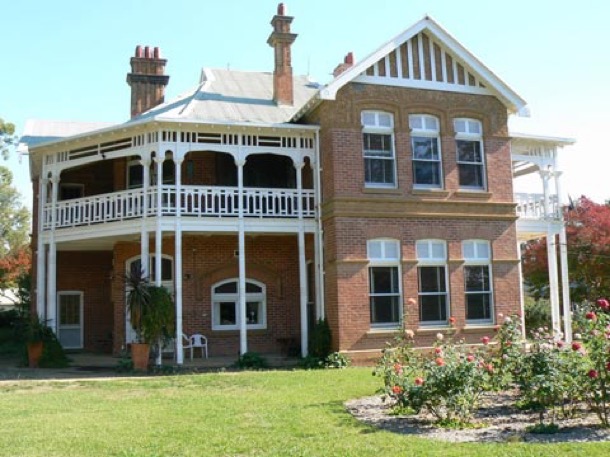
Towong Hill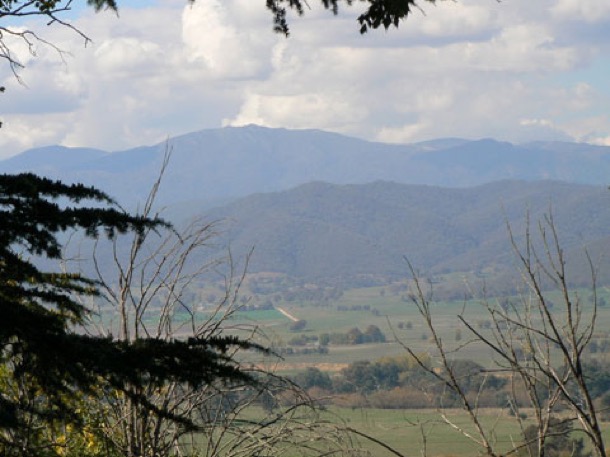
View from the house
We stayed upstairs in four of the many bedrooms. I remember white sheets and dark furniture and curtains blowing in the breeze. It was dark and cool downstairs, when we came down to breakfast the next morning. All the meals were served in the large formal dining room adjacent to a huge country kitchen. I remember Mrs Mitchell had biscuits, fresh tomatoes and herbs for lunch. No wonder she cut such a lean athletic figure.
After we had been introduced to the many lovely farm dogs and seen the horses and stables, Mrs Mitchell suggested that a swim might be beneficial for our aches and pains. We drove down the hill to the river flats and the Mitchell's favourite swimming hole in a billabong of the Murray River. Bliss! It was still quite hot.
A last dinner in this world away and then the long drive back to reality. Fred’s brother Phillip was picking us up in the morning.
We did not realise at the time that we would not go to Albina Hut together again. Somehow that accident fractured the foursome but the friendships formed were to continue in a different forms for each of us.
First Year Teaching 1909
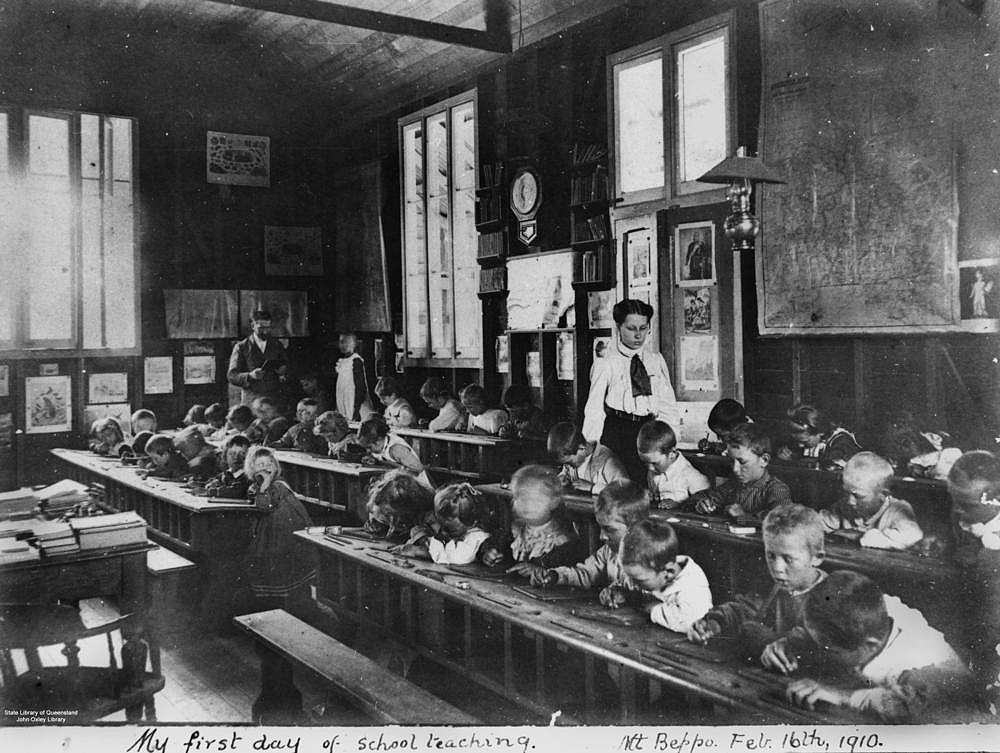
These children, photographed in 1910, are writing on slates with chalk, as did the children in our grandfather Alf's classroom in 1909. The holes in the desk in front of each child hold inkwells, in which they dipped their pens. The little children are in the front, the older ones at the back.
Alice, our mother, described her father's brief teaching career in 1909-10. The recording was made during the family history taping sessions with her sister Marge, in 1990.
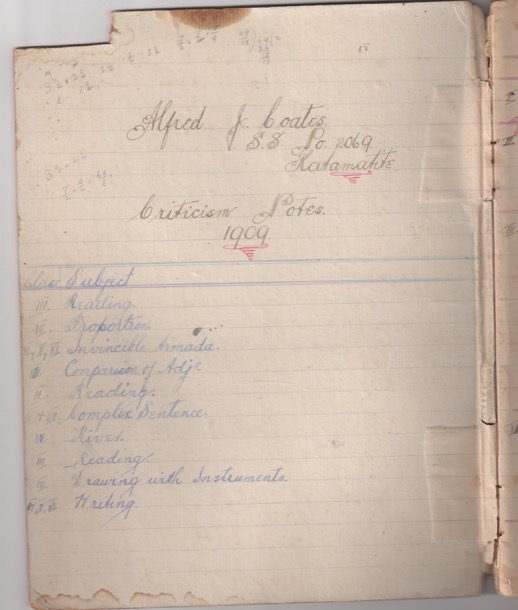
Alfred J. Coates
SS No 2069 (State School number)
Katamatite
Criticism Notes
1909
Class iii Reading
Class iv Proportion
Class iv, v and vi Invincible Armada
Class iv Comparison of Adj's (adjectives)
Class ii Reading
Class v and vi Complex Sentence
Class iv Rivers
Class iii Reading
Class iii Drawing with Instruments
Class iv, v and vi Writing
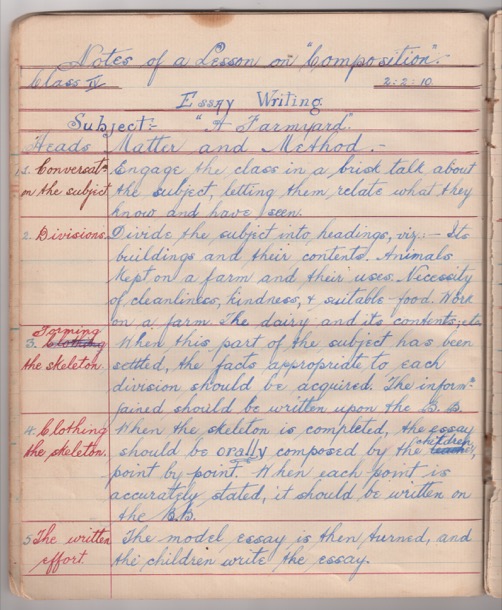
Notes of a Lesson on "Composition"
Class vi 2:2:10
Essay Writing
Subject:- "A Farmyard"
1. Conversation on the subject.
Engage the class in a brisk talk about the subject, letting them relate what they know and have seen.
2. Divisions
Divide the subject into headings, viz :- Its buildings and their contents. Animals kept on a farm and their uses. Necessity of cleanliness, kindness, and suitable food. Work on the farm. The dairy and its contents; etc.
3. Farming the skeleton.
When this part of the subject has been settled, the facts appropriate to each division should be acquired. The information gained should be written on the B.B. (blackboard).
4. Clothing the skeleton
When the skeleton is completed, the essay should be orally composed by the children, point by point. When each point is accurately stated, it should be written on the B.B.
5. The written effort
The model essay is then turned and the children write the essay.
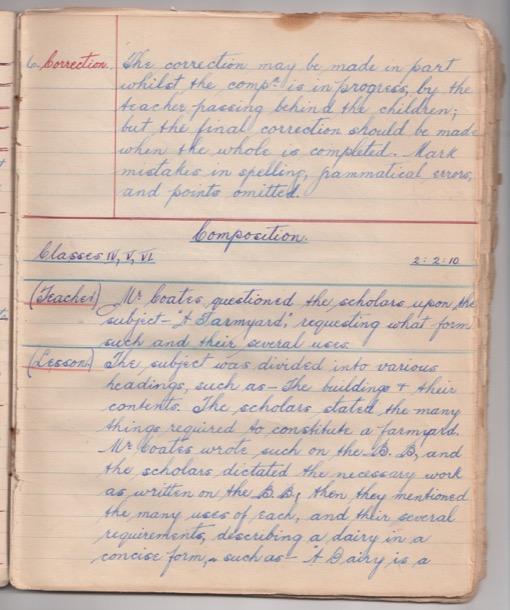
6. Correction
The correction may be made in part, while the composition is in progress, by the teacher passing behind the children; but the final correction should be made when the whole is completed. Mark mistakes in spelling, grammatical errors, and points omitted.
(Lesson critique by Headmaster)
Composition
Classes iv, v and vi, 2:2:10
(Teacher) Mr Coates questioned the scholars upon the subject "A Farmyard," requesting what form such, and their several uses.
(Lesson) The subject was divided into various headings, such as - The buildings and their contents. The scholars stated the many things required to constitute a farmyard. Mr Coates wrote such on the B.B, and the scholars dictated the necessary work as written on the B.B., then they mentioned the many uses of each, and their several requirements, describing a dairy in a concise form, such as - "A Dairy is a
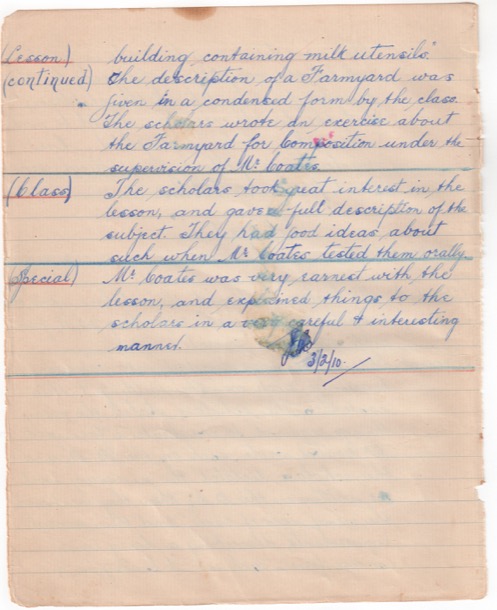
(Lesson) (continued) building containing milk utensils." The description of a Farmyard was given in a condensed form by the class. The scholars wrote an exercise about the Farmyard for Composition under the supervision of Mr Coates.
(Class) The scholars took great interest in the lesson and gave full description of the subject. They had good ideas about such when Mr Coates tested them orally.
(Special) Mr Coates was very earnest with the lesson, and explained things to the scholars in a very careful and interesting manner.
JM
3/2/10
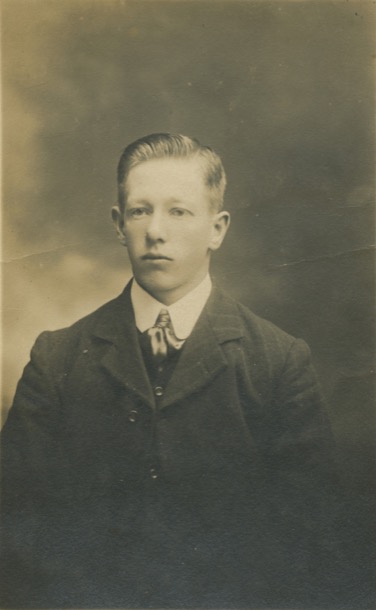
Alf 1910
Marge and Alice went on to discuss some other aspects of Alf's early life.
More of Alf's Teaching Notes are available in the Resources Page, which can be accessed from the Navigation Bar at the top of this website. If you are using a phone, or a tablet in portrait rather than landscape, click the tiny + under the logo and heading, to reveal the Navigation options. Our site is much better viewed on a computer or at least in landscape rather than portrait.

